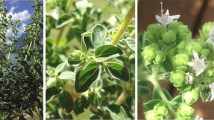Abstract
The aim of this study was to evaluate the toxicity of rice bran supercritical CO2 extract (RB-SCE) in vitro and in vivo. A cytotoxicity assay revealed no inhibitory effects on cell viability in a mouse leukemic monocyte macrophage cell line (RAW 264.7) after 24-h incubation with 0.16 or 0.32 μg/mL of RB-SCE. RB-SCE was administered to male and female Sprague-Dawley rats at 2,500, 5,000, or 10,000 mg/kg to evaluate acute oral toxicity. Mortality, clinical symptoms, and body weight changes were monitored for two weeks. Animals were then euthanized and necropsies performed. Clinical symptoms included soft stool, diarrhea, and soiled perineal region. No significant changes in body weight were observed in treatment groups compared to the control. In addition, necropsy revealed no abnormal finding at any dosage. The approximate lethal dose (ALD) of RB-SCE was estimated at >10,000 mg/kg for both sexes and orally administered RBSCE was deemed safe.
Similar content being viewed by others
References
Manosroi, A. et al. Biological activities of the rice bran extract and physical characteristics of its entrapment in niosomes by supercritical carbon dioxide fluid. J. Supercritic Fluids 54, 137–144 (2019).
Li, S. C., Chou, T. C. & Shih, C. K. Effects of brown rice, rice bran, and polished rice on colon carcinogenesis in rats. Food Res. Inter. 44, 209–216 (2011).
Jariwalla, R. J. Rice-bran products: phytonutrients with potential applications in preventive and clinical medicine. Drugs Exp. Clin. Res. 27, 17–26 (2001).
Ruksiriwanich, W., Manosroi, J., Abe, M., Manosroi, W. & Manosroi, A. 5-Reductase type 1 inhibition of Oryza sativa bran extract prepared by supercritical carbon dioxide fluid. J. Supercritic Fluids 59, 61–71 (2011).
Choi, J. S. et al. In vivo hair growth-promoting effect of rice bran extract prepared by supercritical carbon dioxide fluid. Biol. Pharm. Bull. in press.
Proctor, A. & Bowen, D. J. Ambient-temperature extraction of rice bran oil with hexane and isopropanol. J. Am. Oil Chem. Soc. 73, 811–813 (1996).
Xu, Z. & Godber, J. S. Comparison of supercritical fluid and solvent extraction methods in extracting coryzanol from rice bran. J. Am. Oil Chem. Soc. 77, 547–551 (2000).
Pezzoli, G., Ricciardi, S., Masotto, C., Mariani, C. B. & Carenzi, A. n-hexane induces parkinsonism in rodents. Brain Res. 531, 355–357 (1990).
Karakaya, A., Yücesoy, B., Burgaz, S., Sabir, H. U. & Karakaya, A. E. Some immunological parameters in workers occupationally exposed to n-hexane. Hum. Exp. Toxicol. 15, 56–58 (1996).
Yeddes, N., Chérif, J. K., Jrad, A., Barth, D. & Trabelsi-Ayadi, M. Supercritical SC-CO2 and soxhlet n-hexane extract of Tunisian Opuntia ficus indica seeds and fatty acids analysis. J. Lipids. 914693 (2012).
Sahena, F. et al. Application of supercritical CO2 in lipid extraction — a review. J. Food Eng. 95, 240–253 (2009).
Organization for Economic Co-Operation and Development. OECD Guideline (423) for testing of chemicalsacute oral toxicity-acute toxic class method (2001).
Korea Food and Drug Administration. Toxicity test standard of drug etc. Notification No. 2012-86 (2012).
Choi, W. C., Jung, I. C., Lim, J. S., Kim, S. H. & Lee, S. R. Single oral dose toxicity test of ACM (added Chongmyung-tan) in Sprague-Dawley rat. J. Orient. Neuropsychiatry 23, 121–128 (2012).
Globally Harmonized System of Classification and Labelling of Chemicals. New York and Geneva, United Nations (2011).
Kim, S. R. et al. Rat single oral dose toxicity test of Armeniacae Semen (including endocarp). Kor. J. Orient. Int. Med. 33, 145–159 (2012).
An, H. J., Hwang, S. Y., Lee, J. R., Kim, S. C. & Jee, S. Y. 28 days repeated oral dose toxicity test of “hyeonggaeyeongytang” extract in SD rats. Kor. J. Orient. Med. Prescrip. 16, 147–168 (2008).
Roh, M. K. et al. Characteristics of Extraction and Fatty Acid Composition for Rice Bran Oil by Supercritical Carbon Dioxide. J. Supercrit. Fluids (in press).
Korea Food and Drug Administration. Good Laboratory Practice (GLP) standards. Notification No. 2012-121 (2012).
Organization for Economic Co-Operation and Development. Principles of Good Laboratory Practice, ENV/MC/CHEM(98)17 (1997).
Author information
Authors and Affiliations
Corresponding author
Rights and permissions
About this article
Cite this article
Choi, JS., Moon, WS., Moon, JN. et al. Cytotoxicity and single-dose oral toxicity testing for rice bran supercritical CO2 extract. Toxicol. Environ. Health Sci. 5, 215–220 (2013). https://doi.org/10.1007/s13530-013-0175-4
Received:
Revised:
Accepted:
Published:
Issue Date:
DOI: https://doi.org/10.1007/s13530-013-0175-4




